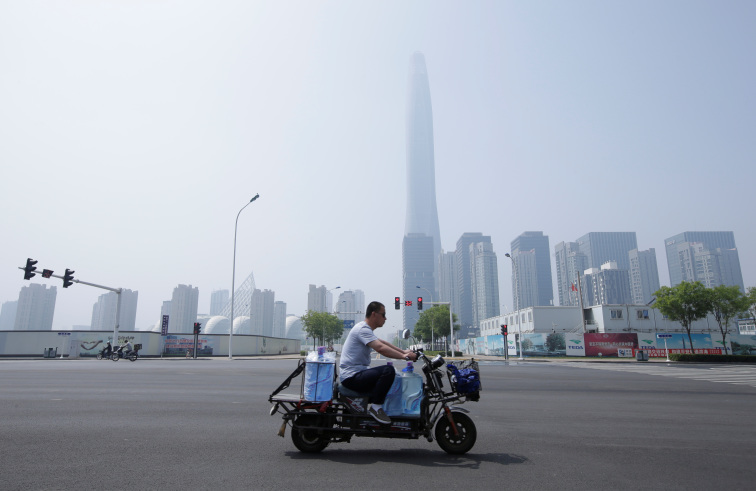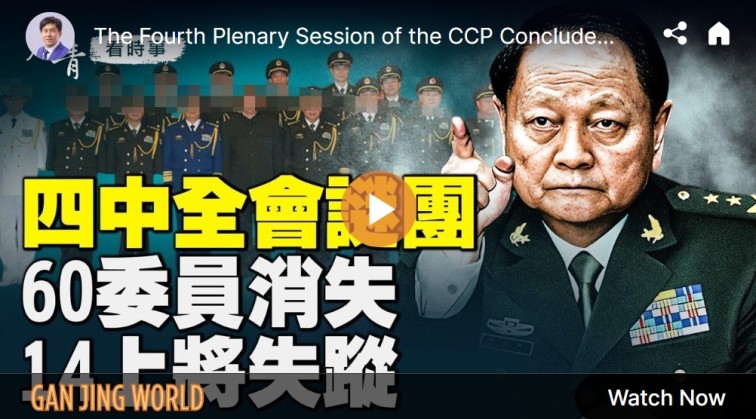In recent years, as China’s economy has continued to deteriorate and housing prices have plummeted, a “new type of poor” is spreading across first-tier cities like Beijing and Shanghai. (Video screenshot)
[People News] The Fourth Plenary Session once again emphasized “taking economic development as the central task,” but it proposed no real solutions for the future economy. From beginning to end, it was nothing but empty talk and recycled clichés — clear proof that the CCP is no longer an effective government but a terminally ill patient surviving on life support day by day.
In recent years, all of the CCP’s economic “rescue” measures have been nothing more than treating the symptoms — never the root cause. The decline of China’s economy stems from a major political regression: aggressive “wolf warrior” diplomacy externally and a policy of “the state advances, the private sector retreats” internally. Without correcting this political backsliding, the economy is bound to continue its downward slide.
But the CCP knows that correcting Xi Jinping’s hardline leftist course would mean suppressing the planned economy, indirectly encouraging Western-style democracy, and ultimately threatening its totalitarian rule. Therefore, this “door” cannot be opened. Since it involves regime security, the Party will cling to it until death.
Fiscal Collapse Following Economic Crisis
The economic crisis has now produced a fiscal crisis. From the central government down to local governments, all are trapped in severe financial distress. It is estimated that the “full-caliber” debt of the central and local governments combined has reached 100 trillion yuan, equivalent to 124% of GDP. Both central and local authorities are suffocating under the weight of debt. The real problem is that there is no cure in sight; the situation will continue to deteriorate, and the pace and magnitude of the decline will only intensify. So where is the road ahead? If there is no way out, how much longer can they hold on?
Earlier, a district government in Shanghai was reported to have borrowed money from a Buddhist temple; other reports about deep-sea fishing schemes and mandatory social insurance deductions are further examples of desperate, stopgap “self-mutilation” tactics — cutting off one’s flesh to patch a wound. But there’s a limit to how much flesh can be cut — such measures can’t sustain a long-term cure.
“Three Assets Reform” — Monetizing Everything
Recently, Hubei Province launched a new policy called the “Three Assets Reform”, which proposes that “all state-owned resources should be as much as possible turned into assets, all state-owned assets should be as much as possible securitized, and all state-owned funds should be as much as possible leveraged.” The policy employs four principles: use it if it can be used, sell it if it can’t, lease it if it can’t be sold, and finance it if possible — to push forward this reform.
What does that mean? “State-owned resources” refer to six categories — minerals, forestry, water, energy, land, and data. “State-owned assets” refer to five categories — physical assets, equity, debt, franchise rights, and future income rights. “Funds” refer to “idle and low-efficiency” state-owned money “lying dormant” on accounts.
To illustrate: imagine an ancient town with a five-li stone bridge built during the Song Dynasty — known as “the longest bridge under heaven.” It originally belonged to local residents, but after the CCP came to power, it naturally became state property, which in effect means CCP property. In the past, anyone could cross it freely; locals and the government jointly raised funds to maintain it, without charging visitors or passersby.
Now, however, the local government has no money and cannot allow such “state-owned resources” to sit idle. It must “turn them into assets.” That means people might soon have to pay a toll to cross the bridge or visit the site. Wealthy locals may be charged for maintenance fees, providing the government a small new revenue stream. Though the amount may not be large, “small sums add up,” as they say. Besides, the area also has the Longshan Temple (the ancestral temple of over 100 temples of the same name in Taiwan) and historical sites linked to Zheng Chenggong and Zhu Xi. All these can be “assetized.” “Where there’s a mountain, there’s firewood to cut.” This is what they mean by “turning state-owned resources into assets.”
Taking it further — if the entire ancient town’s tourism resources are bundled into a company that sells shares to private investors, it becomes “securitized.” If that company is then outsourced to private operators with a 10-year or 50-year franchise, providing the government with a fixed income, that income can be used as collateral for more loans from banks — this is “leveraging.”
Though I’m not an economist, it’s easy to guess that this is the basic logic behind Hubei’s “Three Assets Reform.” China is vast, and every province and city has its own “state-owned resources.” These are to be turned into assets, then into securities, then into leverage — the magic all lies in that one word, “transformation.”
This is like a family that’s run out of money and starts rummaging through every corner — under beds, in the kitchen, in dark corners — to find anything of value to sell, just to get by for a while. Hubei has mountains, rivers, forests, and minerals — plenty to “transform.” But in the future, even villagers who go to the hills to dig bamboo shoots, gather mushrooms, keep bees, chop wood, or fish in rivers and lakes will likely have to pay fees, because the government will have turned all of it into “assets,” into profit-making tools.
The Desperate Struggle for Money
Local governments need money. Where will it come from? Naturally, from the people’s pockets. The officials are targeting the people — competing with them for profit in business, and draining them dry outside of it. This shows how desperate they have become.
Earlier, the central government ordered local governments to “cut ties” with their local financing platforms — effectively allowing local governments to default on debts those platforms had borrowed. The financing platforms are now treated as companies, and if they go bankrupt, the government claims it’s “not responsible.” This was a preemptive “get-out-of-jail card” from Zhongnanhai — a dark scheme hatched by a gang of rogue proletarians.
But who did these local financing platforms borrow from? Of course — state-owned and commercial banks. So when the local platforms default, the losses fall on the state banks. In other words, the central government frees local governments from their debt burdens but transfers the noose onto the necks of the state-owned banks. What kind of absurd trick is this? It’s a “live for today, die tomorrow” tactic — the mark of a spendthrift scoundrel.
How long can such “self-mutilation to patch wounds” last? There’s only so much flesh on the body — eventually, you’ll cut yourself to death. “Care not for tomorrow’s troubles” — but how many tomorrows are left?
During the Hong Kong anti-extradition protests, I predicted that the CCP regime would collapse — in as few as five years, at most ten. Looking at it now, it seems more like three to five years. It may still draft the 15th Five-Year Plan, but whether there will ever be a 16th one is very doubtful.
(Author’s Facebook post) △











News magazine bootstrap themes!
I like this themes, fast loading and look profesional
Thank you Carlos!
You're welcome!
Please support me with give positive rating!
Yes Sure!